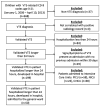Development of a new risk score for hospital-associated venous thromboembolism in noncritically ill children: findings from a large single-institutional case-control study
- PMID: 25064163
- PMCID: PMC7269107
- DOI: 10.1016/j.jpeds.2014.05.053
Development of a new risk score for hospital-associated venous thromboembolism in noncritically ill children: findings from a large single-institutional case-control study
Abstract
Objective: To determine risk factors for pediatric hospital-associated venous thromboembolism (HA-VTE) in noncritically ill children to derive a novel HA-VTE risk model for this population.
Study design: Patients with HA-VTE were identified retrospectively via the electronic health record at All Children's Hospital Johns Hopkins Medicine from April 10, 2013 through January 1, 2006. Seven contemporaneous, noncritically ill control children were randomly selected for each case of HA-VTE. The association between putative risk factors and HA-VTE was estimated with ORs and 95% CIs, which were calculated using the Wald method. A P-value threshold ≤.2 was used in univariate analysis for inclusion into a multivariate (adjusted) model.
Results: Fifty cases of HA-VTE occurred in noncritically ill children. The presence of a central venous catheter (OR 27.67, 95% CI, 8.40-91.22), infection (OR 10.40, 95% CI, 3.46-31.25), and length of stay ≥4 days (OR 5.26, 95% CI, 1.74-15.88) were found to be statistically significant risk factors for HA-VTE. An 8-point risk score was derived in which scores of 8 points, 7 points, and ≤6 points corresponded to venous thromboembolism risks of 12.5%, 1.1%, and 0.1%, respectively.
Conclusion: The presence of a central venous catheter, infection, and length of stay ≥4 days are significant risk factors for HA-VTE in noncritically ill children, forming the basis for a new risk score that could inform venous thromboembolism prophylaxis decision-making. These findings warrant prospective validation.
Copyright © 2014 Elsevier Inc. All rights reserved.
Conflict of interest statement
The authors declare no conflicts of interest.
Figures
Comment in
-
Hospital-acquired venous thromboembolism in children: call-to-action.J Pediatr. 2014 Oct;165(4):652-3. doi: 10.1016/j.jpeds.2014.06.066. Epub 2014 Aug 6. J Pediatr. 2014. PMID: 25108540 No abstract available.
References
-
- [Accessed June 17, 2014];United States Surgeon General’s Call-to-Action for Deep Vein Thrombosis. 2008 [cited 2012]. Available at: http://www.surgeongeneral.gov/topics/deepvein/calltoaction/call-to-actio....
-
- Stein PD, Kayali E, Olson RE. Incidence of venous thromboembolism in infants and children: data from the National Hospital Discharge Survey. J Pediatr. 2004;145:563–5. - PubMed
-
- Raffini L, Huang YS, Witmer C, Feudtner C. Dramatic increase in venous thromboembolism in children’s hospitals in the United States from 2001 to 2007. Pediatrics. 2009;124:1001–8. - PubMed
Publication types
MeSH terms
Grants and funding
LinkOut - more resources
Full Text Sources
Other Literature Sources
Miscellaneous


